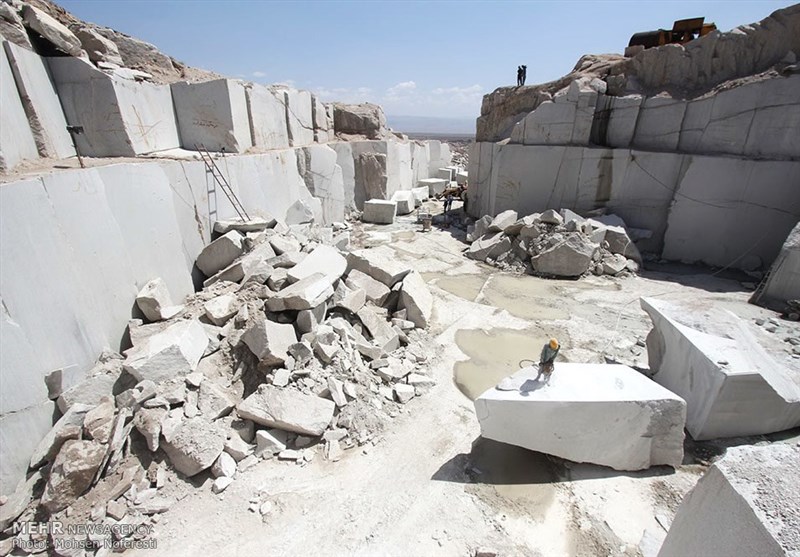What is ore and types of ore
rock or soil
From a geological point of view, rock refers to materials from the earth’s crust that are made of one or more minerals that are linked together. On the other hand, soil is a mass of particles with separated or loosely connected grains, which is formed due to the weathering of rocks. However, in engineering and construction works, the drilling ability of geological materials is used as an index in their classification into two groups of rock and soil.
The origin of the formation of stones and pebbles
The two processes of orogeny and mountain erosion in the earth cause stone products to appear.
Factors of orogeny
The pressures of the molten sphere inside the earth, which enters the solid crust of its surface, can be called the cause of orogeny and terraforming process.Weathering or erosion factors
Any of several processes that break down and change the shape of the hard materials of the earth’s surface and materials that are in contact with the atmosphere is called weathering. Erosion or weathering factors are divided into two physical and chemical groups.
Chemical weathering
It is the product of hydration, dissolution, dehydration, oxidation, or the reaction of acidic waters with rock forming solutes.
Physical weathering
This phenomenon is formed by factors such as frost, temperature changes in the atmosphere and as a result of expansion and contraction, gravity, plant growth, wind, water flow and the action of animals and the like, and it causes rocks to be crushed and their shape changed into smaller grains. .
Chemical structure of rocks
The stones themselves are made of simpler parts called minerals. Minerals are solid, natural, usually crystalline, inorganic, homogeneous materials with specific chemical compositions.So far, more than 3000 minerals are known in nature, of which only about 24 minerals are abundant in the rocks of the earth’s crust, and they are called rock-forming minerals.
Chemical classification of rocks
Because the minerals that make up the stones are diverse, depending on the amount of some other chemical compounds in them, they divide the stones into four categories:
Carbonates
Sulfates
Oxides
Silicates
Classification of rocks according to the way of formation
According to the way of formation, rocks are divided into the following three groups:
Sedimentary rocks
Igneous rocks
Metamorphic rocks
Sedimentary rocks
Some rocks are formed as a result of sedimentation of materials in water. Rivers carry a lot of material with them to the seas and lakes. These materials go to the bottom of the sea due to their weight.They are placed on top of each other and after hardening, they form rocks that are called sedimentary rocks. Sedimentary rocks are layered and the color or material of each layer is different from the other layer. Sedimentary rocks are found in abundance in Alborz and Zagros mountains. Sand, gravel and limestone are examples of sedimentary rocks.
Igneous rocks
Another group of rocks are formed by the cooling of very hot material that was already in the earth. The temperature deep in the earth is high and it melts some rocks. These rocks cool again under or on the surface of the earth and form rocks called igneous. The rocks of mountains like Damavand and Alvand are igneous. Igneous rocks are composed of fine or coarse crystals.Metamorphic rocks
Some sedimentary or igneous rocks, if they stay deep in the earth for a long time, must withstand a lot of pressure and heat. These rocks are baked like bricks and lose their original shape, and that’s why they are called metamorphosed rocks. (like marble)
Application of stone
Stones and minerals are used in construction, industry, medicine, etc.
Types of building stones
These stones are named in various categories, and sometimes the name of the stone mine is used as its name.Environmental pollution, frost and rotting in metal parts and the presence of weak veins as well as poor implementation operations also cause the destruction of stones.
Effect of soluble salts
If the moisture, which has dissolved salts with it, evaporates from the surface of the stone, it will leave some salt on its surface in the form of scale and a layer in the pores of the stone. Continuation of moisture-evaporation cycle increases the volume of crystals and flaking of the stone surface. Therefore, rocks that are more porous are more sensitive to dissolved salts.
Pollution
Rocks with calcium carbonate minerals are especially sensitive to acidic environments. Sulfur oxide in a humid environment and oxygen in the air produces sulfuric acid, which affects limestone and produces calcium sulfate. Limestones and calcareous sandstones are more sensitive in this case.In the case of limestone, the calcium sulfate obtained on the surface is washed away by water. But on surfaces that cannot be washed, the surface is blackened by soot and turns into hard crusts and ridges with lime dust around it.
In all types of magnesium-bearing limestones, the formation of magnesium sulfate accelerates the process of decay.
In sandstones, the pores are filled by gypsum (calcium sulfate), the resulting hard crusts often collapse due to thermal expansion differences. Siliceous sandstones, although they are not directly damaged by the attack of acids in the air, but the gypsum produced by limestone causes damage to them due to evaporation resulting from crystallization on their surface.
Marble, which is basically calcium carbonate, is attacked by acids in the air, and its polished surface becomes rough over time.But due to its dense texture, it is less affected by crystallization.
Frost effect
Destruction due to frost is more visible in parts of the building such as the place of caps, shades, seat of the building and the bottom of the windows. Generally, limestone and dolomite are more exposed to frost attack than sandstone.
Marble, slate and granite are not affected by frost due to their small porosity.
Corrosion of metals
Rainwater that falls from copper and its alloys to the surface of limestone causes green spots. Rust from iron and steel materials is very hard and difficult to remove from the porous surfaces of stones. The most damage occurs due to the expansion of rusting of iron and steel parts inside the stonework of the facade. For this purpose, all the metal parts used in the installation of the facade must be stainless.
Fire
Fire rarely causes total destruction in stonework.But the surface of granite, marble and sandstone may be blackened or crushed by fire.
Limestones are generally not affected by fire, only light-colored rocks are permanently pink due to the oxidation of the iron in them

